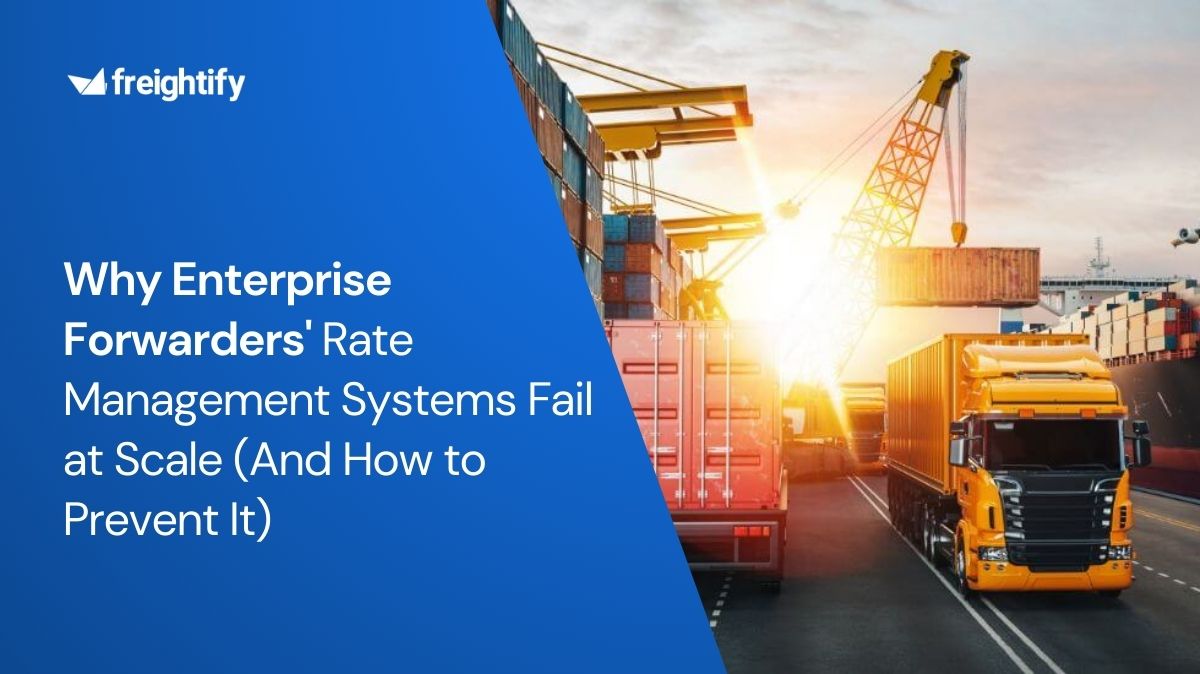Navigating the complexities of international shipping often comes with its fair share of challenges, one of the most significant being detention and demurrage charges. These charges, incurred when cargo remains at ports or terminals beyond the allotted free time, can substantially impact a shipper's bottom line and operational efficiency.
However, with strategic planning, effective communication, and the right tools at their disposal, shippers can proactively minimize these expenses and optimize their supply chain processes. In this guide, we'll explore the top 10 actionable tips for shippers to save on detention and demurrage charges, empowering them to navigate the intricacies of global trade with confidence and efficiency. Let's delve into these strategies to unlock cost savings and streamline shipping operations.
Let us help you with your journey
Your One Stop Solution to Manage Spot, Contract rates & Margins!
Detention and demurrage: Meaning and Purpose While Detention and Demurrage are levied on containers, the fundamental nature and purpose differ.
What is Demurrage? Shipping lines generally give each shipper a certain number of free days to pick up full containers from the terminal; the cost is already built into the freight rates. This is known as free time, and if the container isn’t evacuated from the terminal within the free time allocated, demurrage is levied on a per diem basis.
What is Detention? Shippers are also entitled to a certain number of free days for picking empty containers from the carrier’s Empty Deport, taking them to their premises for stuffing, and thereafter returning the full container to the port.
If the shipper fails to return the container within the free days allocated, detention is applicable for each day over and above the free time that the container is in the shipper’s possession.
Why is detention and demmurage needed? The purpose of levying detention and demurage is twofold.
The first is to ensure optimal usage of carriers’ container equipment and maximize asset turnover.
The second is ensuring that storage space in the port is not unduly occupied due to cargo owners’ tardiness or inability to arrange container evacuation on time.
To discourage shippers from exceeding the allocated free time, detention and demurrage charges are levied on an increasing scale, with the per diem rate increasing as the number of days increases.
While the objective is to drive the right behavior and ensure fast turnaround times, the revenue generated through detention and demurrage fees can quickly pile up. Common causes of Detention and Demurrage While the incurrence of Detention and Demurrage is to some extent inevitable in the normal course of international trade, these are essentially avoidable costs, which often accrue due to the following factors:
1. Lack of knowledge and Understanding This can include a lack of awareness of the granted free time or how it is calculated, leading to miscalculations. Also, employees must be mindful of the potential costs and impact on business and profits caused by detention and demurrage fees, failure to understand could result in inadequate attention.
2. Lack of visibility Given that the transport process involves multiple modes of transport, over vast distances and with multiple stakeholders, the status of the cargo is often unknown to the Shipper, rendering it impossible for them to plan and tackle contingencies.
3. Delayed notifications A corollary of the lack of visibility is the delayed sharing of information. For example, if a notification regarding a vessel being re-routed is shared late, the shipper might not have sufficient time to arrange a timely pick-up.
4. No alerts on various milestones in the shipping process Pre-alerts regarding milestones such as vessel arrival or cargo readiness are crucial in helping shippers plan pick-up and handling
5. Human oversight and inadvertent errors With poor end-to-end visibility and absent timely pre-alerts, the probability of human oversight and inadvertent errors increase significantly, leading to the allowed free time being exceeded.
Let us help you with your journey
Procure, Manage and Quote freight prices (with ancillary charges) in under 2 minutes!
How Shippers can reduce Detention and Demurrage Shippers can mitigate the risk of detention and demurrage charges by taking some elementary precautions and evolving their way of working, as explained below:
1. Advance Planning and Awareness: Educate your team about the intricacies of detention and demurrage charges and their impact on overall shipping costs. By fostering awareness within your organization, you can instill a culture of accountability and prompt action to ensure timely cargo handling. Implement advance planning strategies to streamline operations and meet deadlines, thus minimizing the risk of incurring additional charges.
2. Negotiate Free Time and Waivers: Take proactive steps to negotiate extended free time with carriers based on your specific business requirements. Engage in discussions with shipping lines to secure favorable terms that align with your operational needs. Additionally, explore opportunities to negotiate waivers or reductions in incurred charges, leveraging your business relationship and shipment volumes to your advantage.
3. End-to-End Visibility: Invest in supply chain visibility solutions to gain real-time insights into cargo movement and status. By enhancing visibility across the supply chain, you can proactively monitor shipments, anticipate potential delays, and make informed decisions to avoid detention and demurrage charges. Utilize advanced tracking and monitoring technologies to ensure optimal coordination and efficiency throughout the shipping process.
4. Implement Automation: Embrace automation to streamline manual processes and enhance operational efficiency. By automating routine tasks such as documentation management and cargo tracking, you can minimize errors and delays, thereby reducing the risk of incurring detention and demurrage charges. Leverage technology solutions to optimize workflow processes and improve overall productivity within your organization.
5. Strategic Documentation Preparation: Prioritize meticulous preparation of all necessary paperwork for customs clearance and regulatory compliance. Ensure accuracy and completeness in documentation to expedite clearance processes and prevent potential delays. By organizing and managing documentation effectively, you can facilitate smoother shipping operations and minimize the risk of errors or discrepancies that could lead to detention or demurrage charges.
6. Plan for Customs: Familiarize yourself with customs clearance procedures and regulations applicable to your shipments. Develop comprehensive plans for customs clearance, including pre-clearance activities and documentation requirements, to expedite the process and avoid unnecessary delays. Stay informed about changes in customs regulations and adapt your processes accordingly to mitigate the risk of incurring detention and demurrage charges.
7. Explore Alternative Storage Options: Consider alternative storage solutions, such as off-port facilities, to alleviate congestion and minimize demurrage charges. Evaluate the cost-effectiveness of third-party storage options compared to port storage fees. By strategically utilizing alternative storage facilities, you can optimize inventory management and reduce the likelihood of incurring detention or demurrage charges due to storage constraints.
8. Maintain Effective Communication: Establish clear communication channels with all stakeholders involved in the shipping process, including carriers, terminals, and customs authorities. Ensure open and transparent communication to facilitate coordination and collaboration throughout the shipping journey. By maintaining effective communication, you can address potential issues proactively and minimize the risk of delays or disputes that could result in detention or demurrage charges.
9. Monitor and Analyze Historical Data: Leverage historical data and analytics to identify trends and patterns related to detention and demurrage charges. Analyze cargo dwell times at specific ports or terminals to pinpoint areas of inefficiency and opportunities for improvement. By monitoring key performance indicators and benchmarking against industry standards, you can optimize planning and resource allocation to reduce detention and demurrage charges effectively.
10. Invest in Technology Solutions: Harness the power of technology to optimize supply chain operations and minimize detention and demurrage charges. Explore advanced technology solutions, such as supply chain visibility platforms, to automate processes and improve decision-making capabilities. Platforms like Freightify offer real-time shipping schedules and end-to-end visibility, enabling proactive planning and execution to avoid unnecessary charges. By investing in technology solutions, you can enhance operational efficiency and drive cost savings across your supply chain.
Popular Supply Chain Visibility Platforms and how they can help Exporters and Importers While there has been a proliferation of supply chain visibility platforms in recent years, some platforms have come to be recognized as market leaders.
One prominent player in this market is Freightify , which has rapidly gained popularity due to its user-friendly interface and advanced functionalities.
The Freightify platform provides real-time shipping schedules and end-to-end visibility of vessels.
Therefore, freight forwarders can make their exporters & importers aware of the precise status of the cargo, which helps them be ready even before the cargo arrives and thus greatly enhances the accuracy of their planning.
The platform also tracks various milestones in the shipping process, enabling timely cargo handling and enabling shippers to adjust in case of delays.
To find out how Freightify can help your forwarding business, schedule a demo by clicking here .




















